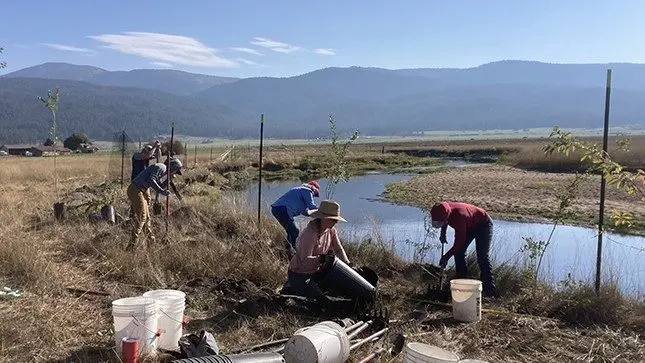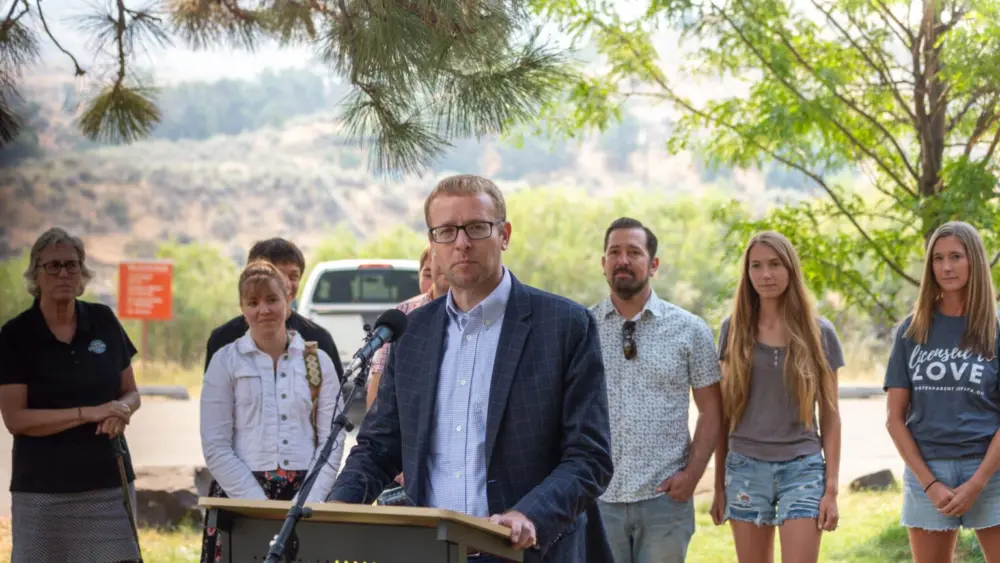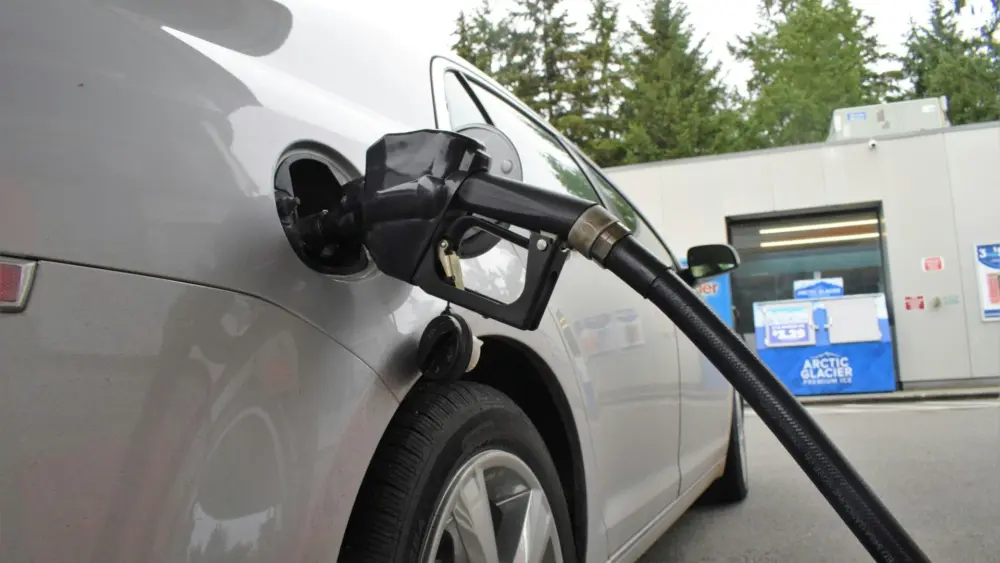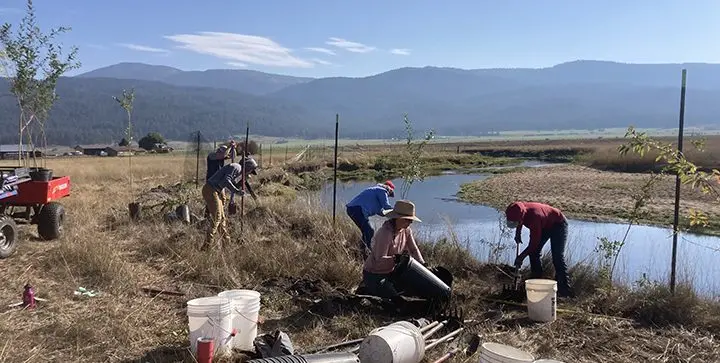This story was first published in the November edition of Conservation the Idaho Way.
NEW MEADOWS, ID – Silas Wilbur remembers fishing for trout on the Little Salmon River as a kid. His parents owned a ranch on the Little Salmon, north of New Meadows, and he used to visit frequently.
“I used to catch a lot of trout on the river, that was really fun,” Wilbur says. “You can’t catch any trout in that stream now.”
Wilbur grew up in Weiser, and his parents ran Texas longhorn cattle on the Meadows Valley property. “That’s some of the best grass in the state,” he notes.
When his parents reached retirement age, they leased out the ranch. During the COVID years, Silas and his wife, April, made a permanent move to the family ranch in Meadows Valley.
They’re still raising cattle on the ranch, and they also have chickens, goats and a llama named Reba.
“We like cattle, but it’s not our first priority, honestly,” Silas Wilbur says. “As soon as we moved up there, we’ve been working on fixing up the place and doing some restoration work on the landscape.”
The Wilburs approached the Natural Resources Conservation Service to learn about what federal assistance might be available. They also had a fortuitous visit from Wes Keller of McCall, who works in the fisheries department for the Nez Perce Tribe. In talking to Keller, they realized that the Nez Perce Tribe had a similar vision for restoring the Little Salmon River to improve riparian habitat for resident fish, steelhead and endangered salmon.
“They used to call this area Chinook Meadows,” noted their neighbor to the north, Kurt Kroll. “I dearly love that place, I’m very grateful to have it.”
Kroll bought his ranch property four years ago. He also has a strong interest in the restoring the property to improve the riparian area and enhance water quality in the Little Salmon River.
Keller talked to Wendy Green, chair of the Adams Soil and Water Conservation District Board of Supervisors, about his conversations with the Wilburs and Kroll. To help improve the Little Salmon River water quality and riparian area fits the district’s mission.
“This section of the Little Salmon is a 303 (d)-listed stream due to temperature, sediment and nutrient loads,” Green said. “We welcomed the opportunity to work with willing landowners to help improve water quality.”
A habitat restoration project — the Idaho way
Green suggested that they could apply for a Water Quality Program for Agriculture grant from the Idaho Soil and Water Conservation Commission to install fencing along the Little Salmon to exclude cattle.
In addition to protecting streambanks from livestock, the riparian buffer would support the Nez Perce Tribe’s effort to plant shrubs and trees to begin the restoration effort. The tribe had significant resources from a larger grant to restore fisheries in the Salmon and Clearwater river basins. But they wanted to make sure that the riparian plantings would be protected from cattle grazing. The fencing project made all of that possible.
“Our goal is to always help our local landowners find resources to accomplish conservation and restoration projects,” said Charlie Munden, a supervisor on the Adams Soil and Water Conservation District board. “We were happy to help.”
The Adams district applied for and received a $23,800 Water Quality Program for Agriculture grant to purchase 1.25 miles of fencing to begin restoration work on 385 acres of land in the Little Salmon River corridor shared by Kroll and the Wilburs. Plus, the Nez Perce Tribe owns 37 acres of land immediately to the north of those properties to tie more conservation projects together.
The riparian fencing was installed in the late fall of 2024. The first round of riparian trees and shrubs were planted by a variety of volunteers in September 2025.
“We’ve been really thrilled with the project so far,” said April Wilbur. “It’s been really wonderful.”
“It’s a beautiful piece of river – I can’t wait to see how things improve over time,” Kroll says.
“The end goal aligned perfectly for all of us,” added Silas Wilbur. “We all want a healthy river. It feels like a win-win-win project all the way around.”
Background: Little Salmon River water quality issues
The Little Salmon River flows north for 45 miles from its headwaters south of New Meadows to its confluence with the main Salmon River near Riggins. The Upper Little Salmon River segment extends 12.5 miles, from Big Creek in the south downstream to Round Valley Creek. This stream segment is on the state’s list of degraded waters (§303(d) list) because it does not meet minimum standards for water temperature, bacteria and nutrients, the Adams district’s grant application noted.
“The proposed Meadows Valley Riparian Fencing Project is the necessary first phase of a comprehensive plan to reduce agricultural impacts and restore beneficial uses in the heart of the Little Salmon River segment that flows through the Meadows Valley,” Wendy Green wrote in the application.
The Wilbur family’s property has 270 acres and 1.4 miles of Little Salmon River in the project area. Kroll has 116 acres and .6 miles of the river in the project area. With the Water Quality Program for Agriculture funding and $13,232 in landowner cost-share contributions, the landowners installed 6,573 feet of riparian fence to restore and protect 1.25 miles of the listed stream, along with significant wetlands.
Livestock are being excluded from 132 acres on both properties. The project also features the following benefits:
- It will meet or exceed a 42-meter riparian buffer in this reach as recommended in the Little Salmon River Total Maximum Daily Load Implementation Plan for Agriculture, 2008.
- It protects more than 15 acres of existing wetlands on the two parcels.
- It allows for future managed grazing in the riparian pastures, once shrubs have become established and streambanks have stabilized.
What difference will the project make for water quality?
Fencing cattle off streambanks can make a significant improvement in water quality. According to the Idaho Department of Environmental Quality, the fencing project will reduce sediment loads by 79 tons per year, nitrogen by 254 pounds per year, and phosphorus by 127 pounds per year.
Both landowners have met with the Natural Resources Conservation Service and begun the process of applying for EQIP federal funds in order to develop off-stream stockwater facilities, improve aging irrigation infrastructure, and refine their grazing plans.
In addition, the Nez Perce Tribe’s Watershed Division has offered expertise, labor, and plant materials to help restore riparian shrubs along the protected river reach. The U.S. Fish and Wildlife Service, through its Idaho Partners for Fish and Wildlife Program, has offered to provide equipment and staff time to assist with implementing BMPs. The Adams district has water-jet stingers available to aid in riparian planting, as well.
“This restoration effort is going to require all hands on deck, and we have received enthusiastic support from many willing partners,” Green said in the Adams Water Quality Program for Agriculture application.
Indeed, the tribe’s staff and volunteers from local schools, Idaho Fish and Game, the Forest Service, Alzar School in Cascade, and the University of Idaho Master Gardener program planted more than 500 trees and shrubs in the fall of 2025. Many more plantings are planned in 2026 and beyond.
The Wilburs signed a contract with the Nez Perce Tribe that details the types of trees and shrubs that will be planted in the Little Salmon River riparian area over time. All told, more than 9,600 trees and shrubs are scheduled to be planted in the next five years. The trunks of the trees were protected with a mesh material to prevent deer from eating them.
Plantings will include:
- Thin-leaf alder
- Serviceberry
- Birch
- Red dogwood
- Black cottonwood
- Aspens
- Six different species of willows
Keller was out of the country when contacted for this story and was not available to comment. But Silas Wilbur gives him a lot of credit for pulling all of the partners together for the Little Salmon River restoration project.
“Wes was really excited after our initial conversation, knowing that we all had a similar long-term vision for the Little Salmon River,” Wilbur said. “He worked his butt off on this project, quite frankly. We could not have done it financially without the WQPA grant and the tribe’s assistance.”
“I’m starting to see positive changes in the river already,” he says. “I’m looking forward to catching trout in the Little Salmon once again.”
“Things are looking good so far,” added Kroll. “I’m looking forward to seeing how things look 5 years from now. I think those plantings are going to grow up and thrive, and we should see a real positive change in the water quality of the river. Hopefully, someday, we’ll see steelhead and chinook spawning up here.”
Steve Stuebner writes for Conservation the Idaho Way on a regular basis.
Idaho Capital Sun is part of States Newsroom, a nonprofit news network supported by grants and a coalition of donors as a 501c(3) public charity. Idaho Capital Sun maintains editorial independence. Contact Editor Christina Lords for questions: info@idahocapitalsun.com.





